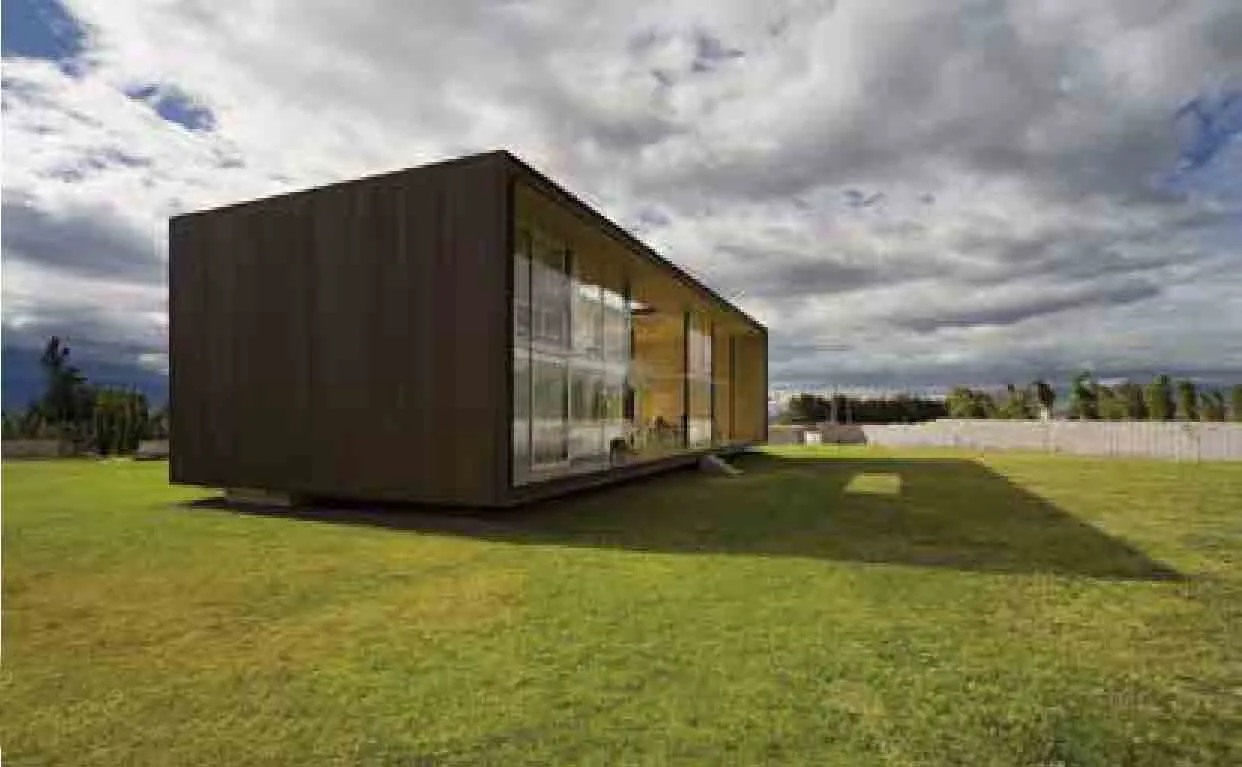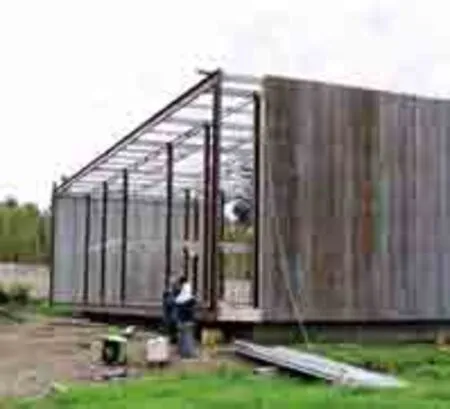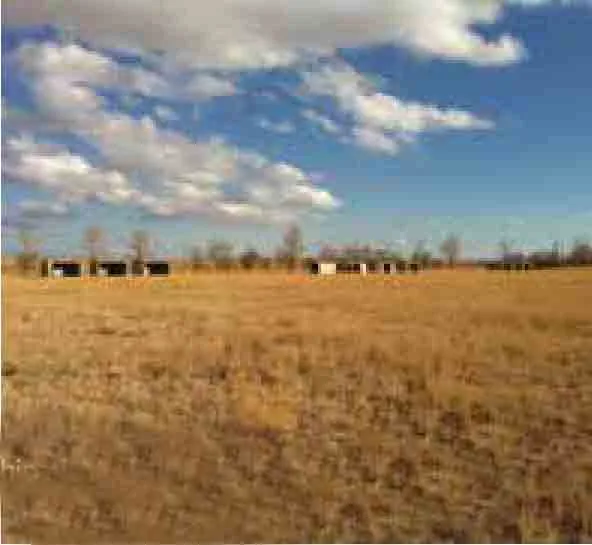From X House to Cotacachi House,Continuity through Variation:Typology + Material
By arquitectura x
材料1
2008基多建筑双年展时,我们举行了技术和建筑研讨会,会上Mauricio Rocha详细叙述了他对一种简单材料应用可能性的探索,并对施工开发和使用此材料构成的形式系统进行了热情讲解。他说的是瓦哈卡州艺术学院的夯土,当时该艺术学院仍在施工中,Mauricio的理念和该建筑都非常引人注目,我们对潜在的可能性充满好奇。
但是,从表面上来说,这种材料和施工工艺与我们当时所进行的工作和发展方向似乎是对立的,我们应该以何种方式、在何种契机使用该材料和施工工艺呢?Mauricio肯定地告诉我们,未来我们会遇到一种情境,只有夯土施工才可解决其中的所有问题,当时机到来时,他会全力以赴地为我们提供帮助,当然,在像厄瓜多尔一样夯土施工具有悠长历史的国家中,这看起来是非常合乎逻辑的。
根据(可调整、非程序化、灵活且通用的)空间和(预先建造、组装、灵活且通用的)建筑物之间的直接关系,怎样将夯土施工融入到系列开发中?
Mauricio非常慷慨大方,向我们展示了一处令人惊叹的、且正在施工中的建筑,并向我们提供了改善和加强夯土所需的所有技术和事实信息,最重要的是为我们解决了一个关键性问题。
类型1
这个时候,我们正努力将通用房屋、x房屋的设计方法落实到其他地方的房屋施工中,房屋类型和规模有所变化。我们首先通过建筑物的构成系统对建筑物进行了解,或将建筑物分成:空间、组织、结构、外层保护、服务或更多相关系统来了解;然后,根据比如规模、用途或气候因素,确定一个可以主导其他系统,并可决定建筑物运行方式、形状及与环境关系的系统(或系统组合)。
因此,例如一个市场建筑由其结构系统和外层保护系统(屋顶、太阳能和通风控制)来决定,而对一处房屋来说,空间系统支配其他所有系统(公共和私人、内部和外部间的关系);两种情况中,主导系统都是建筑的形式系统。
这一工作方法主要侧重于在建筑中应用非程序化和非造型式方法,以实现建筑物的开放性、渗透性、灵活性、可修饰性、可调整性或可逆性,使建筑物更好的应对用途、移动性、程序化限制模糊化、工作-生活关系、家庭或工作结构、城市更新-循环不断提出的变化要求,增加公共空间和绿地空间的质量和数量等。
该方法的工作原理非常明确,但是我们发现在应用该方法时,仍然需要考虑许多随意的决定,特别是当该过程中的客户或专业人士提出表面、非实质性意见作为设计基础时。为应对这一问题,必需从设计伊始,便确定好建筑物系统的构建原则和规律及其之间的关系,以保证从建筑理念到形式化再到施工有一个清晰、符合逻辑的过程。
这便又关系到x房屋及其通用性质,它的一系列通用理念是怎样根据现场、环境、用途、施工和物质化被一步步落实的。
我们发现,在这种情况下将类型符合的通用建筑原理作为项目开始建造的主要工具,可以非常有效地去除设计过程中的任意和非实质性因素,尤其可将设计立即转向基本元素,让原始理念通过一个可靠的概念基础,经过合理过程,发展成一个具体的建筑项目。
我们知道,通用原理来自于建筑学科和历史本身,也来自于建筑中对我们来说作为整体经验不可或缺或相关部分的提炼。所以我们提出了类型图概念,通过抽象和目的作用将类型丰富化、精炼化和集中化到项目图表中。这一策略可通过引入具体现实参数,改良从原理到图表的通用(必要)元素,所引入的具体现实参数必须符合项目的时间和场地。
材料2
随着项目的设计方法越来越清晰并形成严谨概念,形式化过程便与我们一直探索、并形成x房屋的组合、预先建造和干地施工系统密切相关,其中具有决定性作用的是施工元素和行为的简化和减少。通过一系列关键决策,施工和物质化符合我们工作中的部分预测;这样便可更有效地对建筑过程进行系统化,从而使更有效的应用设计方法成为可能:因为我们通过已验证的系统对形式化过程有更多控制,我们便可更侧重于类型或图表的变化,将形式与施工系统统一起来。

Mauricio Rocha Oaxaca Arts School Mauricio Rocha 瓦哈卡州艺术学院

Earth construction in Cotacachi科塔卡奇夯土施工

x house x 房屋
设计过程是在实体化过程中,有效地融合具体现实因素的,让其在项目的时间和地点方面具有连贯性、可行性和功能性。因此,材料和施工对建筑项目的逻辑形式化中发挥着关键作用,必须作为类型图表决定方面的组成部分。我们的工作地点具备现成的干地施工工艺和预制材料,如果这些条件不存在时,应该如何应对呢?事实上,整个国家范围内都可获得这些材料,并可找到小型制造商,所以这不是当地可用性的问题,而是材料和技术的合理使用问题:与当地条件、现场和场地、气候、可用劳动力、客户需求相适应,但最重要的是与建筑项目的理念实体化相适应。

Courthouses projects: typical building and adaptation to "specific answer"法院大楼项目:典型建筑及针对“具体答案”的调整
类型2
科塔卡奇房屋的客户是来自加勒比地区的一对夫妇,一段时间以来,他们一直为自己在科塔卡奇的第二套住宅寻求设计方案(科塔卡奇是位于安第斯山北部的一个小镇,从基多向北两个小时的距离);他们需要在离开厄瓜多尔前的4天内收到设计方案,否则就将该地出售。
第一次见面中,我们对客户的想法有了大体的了解:他们的首要关注点是房屋和安第斯山之间的关系及私人和公共空间之间的区分。但是,他们并没有现场图片或完整的总平面图,仅有一张略图,描绘了一块海拔2470米位于山谷中的长矩形果园地块,向东、向西分别为因巴布拉和科塔卡奇山脉。
当时,首要关键条件已经非常明了,其地基环境与我们x房屋的地基环境条件相同,所以这个项目也需采用同样的parti,即一种可适用于所有特定现场条件的通用策略:一座透明的双核庭院结构房屋,其空间限制因素为我们已知的山谷两边的山脉。使用了相同类型图表地基。
同样,通用因素概念在x房屋建造过程中也发挥着基础作用,因为通用因素作为一套有效规则,对通用和具体因素起着协调作用,并且通用和具体因素之间形成了一个开放式的构架,在强化parti/图表本质的同时,也可按照具体条件作出变化和调整。
类型+材料
我们需要将此基础类型图表植根于相应的现实环境中,在不失去parti/图表形式(类型)特性的情况下,明确其细节,但是由于上述工作和时间限制,我们不得不迅速决定哪些具体因素从开始便需发挥作用并控制其他因素。
在这方面,客户已提到科塔卡奇,第二个关键条件便已了然:夯土施工和Mauricio Rocha的经验。这意味着对下列理念的有效应用,该理念强调材料和施工因素从一开始便在通用和抽象因素转化为与当地条件相符的具体和统一因素过程中,及完成类型图表的过程中发挥着关键作用。
夯土施工意味着要了解当地建筑传统中蕴含的启示,及其通过推理得出的、从项目开始便发挥关键作用的设计因素。如果从一开始便要做出决定,那从一开始我们就会面对更多的设计限制,但是,这也让我们立即获得一定自由,无需就审美或造型(表象)方面做出相关决定,重要的是,无需与客户讨论这方面的决定,我们从而可以严格按照材料性质规则、合理建造技术及符合图表类型的形式规则,实现房屋的形式化。
作为一个初始条件,夯土施工有自己的一套规则,这套规则直接与形式和几何结构相关,不允许工作逻辑中出现太大的变化。在厄瓜多尔北部地区的传统方法中,夯土施工也直接涉及到一套建筑形式,这些形式几乎全部基于庭院式建筑。因此,材料及其内在逻辑影响着建筑类型,并决定着形式的调整,及最终新类型图表的形成。
类型+材料=变化中的统一:
当客户肯定了我们首版方案,同时我们也收集完所有必要信息,并对项目的全部条件进行全面分析后,我们便可对初始原则做出最终决定,进而完成项目的类型图表和总体框架:
在地震发生频率非常高的地区进行夯土建造,意味着施工中必须严格遵守几何结构规则,而这些规则不一定会让房屋受到山脉限制,或产生变化,从而更加适应地势、场地几何结构、果园树木和客户提出的用途需求。同时,对当地施工工艺的完全遵守,也可能导致陷入造型元素和完全复制当地规范的风险。
通过当地传统材料施工进行形式化,意味着在该过程中,采用了材料与环境整体相关的方式,因此无需在将通用因素转化为具体建筑方面做任何决策。
若材料逻辑从一开始便影响图表,那么我们就必须对此类逻辑进行抽象,了解当代夯土施工中几何结构、形状和建筑所必须保留的基本条件。大型统一墙面双向分布,按要求加固*,排列在开间中,形成了主要系统。(*基本按照厄瓜多尔建筑规范和Mauricio Rocha的技术意见,混合水泥进行加固。)
传统庭院房屋,第一层建造承重土墙,第二层和屋顶为木制,抽象为庭院式,在本情况下,由三个不同用途的开间形成:夫妇和客人共用的公共开间、庭院隔开的客人私人开间和在这两个开间顶上供夫妇私人使用的第三间开间。形成庭院的两个平行开间按照房屋受山地而不是本身限制的parti原则被移开。
主承重墙开间系统由次级轻型结构系统补充并与之相互作用,这一设计来源于当地的施工逻辑,即第二层和屋顶为轻型木制结构,建造于底座第一层的重型系统上;该系统由作为窗户或屏幕的多层木材和玻璃及木梁构成,第二层和房顶的木梁中加入了薄混凝土板。

x house diagrams x房屋分析图
按照材料逻辑进行的系统化过程,可让工程专注于开发材料在形式和表现上的可能性,即真正通过实体化将理念形式化。通过这种方式,我们所完成的建筑不仅体现了具体因素,并且体现了当地和通用因素的综合,即走向了一条变化中蕴含统一的路径。

x house under construction施工中的x房屋

Donald Judd Chinati, Marfa, TexasDonald Judd,德克萨斯州玛法镇基安蒂

Donald Judd Chinati, Marfa, TexasDonald Judd,德克萨斯州玛法镇基安蒂

House, earth and wood construction, Cotacachi房屋、夯土和木构造,科塔卡奇
MATERIAL 1
In the context of the 2008 Architecture Biennale in Quito where we had gathered in a seminar to speak about technique and architecture, Mauricio Rocha shared with us in detail his venture into the possibilities of an apparently simple material,explaining with passion the development of a construction and formal system from this one material. It was the rammed earth for the Oaxaca Arts School, at that time still under construction, and both Mauricio and the building were so compelling we were left intrigued by the possibilities.
But how and when could we apply a material and construction technique seemingly opposed to what we were working on and developing at the time? Mauricio assured us we would be faced with a context where earth construction would be the right answer and offered all his help when the time came, of course this seemed very logical in a country like Ecuador where earth construction had a deep-rooted tradition.
How could rammed earth construction be incorporated into a line of development based on the direct relationship between adaptable, non-programmatic, flexible and generic space, and prefabricated, assembled, flexible and generic building?
Mauricio’s generosity had come in the form of showing us an amazing building under construction, and offering all the technical and factual information we could need to work with improved and reinforced rammed earth, but most importantly in the form of a crucial question.
TYPOLOGY 1
At this point in time we were working on implementing the design method of our generic house, x house, to any other house located in any other place, and taking it further to other building types and scales. We started by understanding buildings(and/or urban spaces) through the systems that constitute them, or by systematizing buildings into: spatial, organization, structural, covering - protection, services, or, as many systems as would be relevant; then, depending on scale, use, or climate for instance, determining a system (or a combination of systems) that would rule over the others and define the way the building worked, its form and how it related to its environment.
Thus for example a market would be defined by a structural system and covering- protection system (a roof, solar and ventilation control), whereas a house would have the spatial system rule over the rest (the relationship between public and private, inside and outside); in both cases, the dominating systems become at the same time the formal system of the building.
This working method focuses mainly in undertaking a non-programmatic and nonfigurative approach to architecture, in order to achieve open, permeable, flexible,modifiable, adaptable or reversible buildings, that respond better to the constantly changing conditions of use, mobility, ambiguity in programmatic limits, work-live relationships, family or work structures, urban renewal – recycling, increasing demands in quality and quantity of public space and green spaces, etc.
The method had very clear working principles but we found through its application we still depended on many arbitrary decisions, specifically when superficial,unsubstantial opinion appeared as a basis for design, either from the clients or the professionals involved in the process. To counteract this, the laws and rules established for the systems of the building and their relationships had to be present from the outset of the design, in order to ensure a clear and logical process, from idea, to formalization, to construction of the building.
This related us back to the x house and its generic nature, how it started out from a universal set of ideas to become specific as it adapted to its site, climate, use,construction and materiality.
We found that applying universal architectural principles, in this case conforming a typology, as a primary tool to establish the outset of a project, was a very effective way of eliminating the arbitrary and unsubstantial from the design process, but specially to focus immediately on the essential, allowing those initial ideas to be developed from a sound conceptual base through a reasoned process into a specific architectural project.
We understood universal principles had to come from architectural discipline and history itself but also from abstracting what is essential or relevant to all of us within architecture as an integral experience. So we developed the idea of typological diagrams, where typology is enriched, refined and focused by abstraction and intention into a diagram for the project. This strategy allows the universal (essential),as it progresses from principle to diagram, to be re-formed by introducing the specific parameters of reality that must define the project as an appropriate answer to its time and place.
MATERIAL 2

cotacachi house diagrams科塔卡奇房屋分析图
As the design method for the projects became clearer and conceptually rigorous,the formalization process was strongly related to the assembled, prefabricated, dry construction building system we had been exploring leading to the x house, where simplification and reduction of constructive elements and actions was decisive.Through a series of key decisions, construction and materiality were limited to some predetermination in all of our work; this allowed for a more efficient systematization of the building processes which also led to a more efficient application of the design method: we could focus better on typological or diagrammatic variations as we had more control over formalization trough proven systems, unifying the formal with the construction system.
It is in the materialization that the design process effectively incorporates the specific aspects of reality that will make it coherent, viable and functional within its time and place. Material and construction are thus crucial to the logical formalization of the architectural project and have to be an integral part of the determining aspects of the typological diagram.
The work in our office had been located around places where dry construction technique and prefab materials were readily available, but what to do when they’re not? In all truth you could have access to these materials and small fabricators throughout the country, so it’s not really a question of local availability but rather of an appropriate use of material and technique: appropriate to local conditions,appropriate to the site and place, appropriate to climate, available labor, client needs, but most importantly, appropriate to the materialization of the ideas for the architectural project.
TYPOLOGY 2
The clients for the Cotacachi house were a couple from the Caribbean who had been trying for some time to have a design for their second home in Cotacachi, a small town in the northern Andes two hours north of Quito; they needed a design proposal in 4 days before leaving Ecuador, or they would sell the site.
On a first meeting we got a general overview of the client’s ideas: their priority was the relationship between the house and the Andes, and the division between private and public spaces. However, they had no site photographs or complete site plan,just a sketch that showed a rectangular, long orchard plot in a valley 2470 meters above sea level, located between the Imbabura and Cotacachi mountains, to the east and west respectively.
At that moment a first key circumstance became obvious, we had the same base conditions as for the x house, so this project required the application of the same parti, a universal strategy that could work for any particular site condition:a transparent house whose spatial limits would be the two mountains we know dominate the valley, with a binuclear courtyard organization. The same base for the typological diagram applied.
Also basic to the x house process is the concept of the generic as that space between the universal and the specific, the generic as a set of strong rules that mediate between the universal and the specific, acting as an open framework that allows variation and adaptation to specific conditions, while intensifying the essence of the parti/diagram.
TYPOLOGY + MATERIAL
We needed to root this basic typological diagram to its reality and make it specific without losing the formal (typological) attributes of the parti/diagram, but because of the mentioned working and time constraints, we had to very quickly determine which particular factors would act from the start and rule over the rest.
In this regard, as soon as the clients mentioned Cotacachi, the second key circumstance came into place: earth construction and Mauricio Rocha’s experience.This implied effectively applying the idea that material and construction were to be the key factors in making the universal and abstract, specific and coherent to its local conditions from the outset, completing the typological diagram.
Rammed earth construction meant understanding the implications of local building tradition and all that it inferred as a key design factor, from the outset of the project. If it had to be a determination from the start, restrictions for the design would be greater form the start, but at the same time this freed us immediately from having to make,and importantly not discuss with the client, decisions related to aesthetic or figurative(superficial) aspects, and allow us the freedom to formalize the house following strict rules inherent to the nature of the material and its appropriate building technique while following the formal rules inherent to the typology of the diagram.
As an outset condition then, rammed earth construction comes with its own set of rules related directly to form and geometry that allow very little variation in its working logic. In the case of traditional rammed earth construction in northern Ecuador, it also comes related directly to a set of building types, almost all based on the courtyard type. Thus the material and its inherent logics inform the typology and determine formal adaptations generating a new, final typological diagram.
TYPOLOGY + MATERIAL= CONTINUITY THROUGH VARIATION
After the clients accepted our first proposal, and once all the essential information was gathered and thorough analysis of the complete conditionings for the project was done, we could reach final determinations for the outset principles that would complete the typological diagram and general framework for the project:
Building with earth in a highly seismic region implies you have to work with very strict geometric rules that would not necessarily allow the house to be limited by the mountains, or vary to become more specific to topography, site geometry,trees in the orchard and precise needs of use by the client. Also, strictly applying local construction techniques carry the risk of falling into the figurative and literally reproducing vernacular codes.
Formalization through construction in a local traditional material means you also have implied within this process the way the material relates to its environment as a whole, so again you are freed from having to make certain decisions in making the universal into specific architecture.
If material logics were to inform the diagram from the outset, then we had to abstract these logics, understanding the essential conditions that had to be maintained in geometry, form and construction for contemporary rammed earth construction.Large uniform wall planes distributed bi-directionally and reinforced as required*arranged in bays, became the primary system. (*basically mixed with cement and reinforced according to Ecuadorian building code and Mauricio Rocha’s technical advice.)
The traditional courtyard house, built with loadbearing earth walls for the first story and wooden second stories and roofs, is abstracted to a courtyard type defined in this case by three bays determined by use: a public bay shared by the couple and guests, a private bay for the guests separated by the courtyard, and a third bay atop the other two for private use by the couple. The two parallel bays that define the courtyard are displaced, consistent with the parti principles of a house limited by the mountains and not within itself.
The primary load bearing wall bays system is complemented by, and interacts with,a secondary light construction system, derived from local construction logic of light wooden second stories and roofs that rest over the heavy system at the first story base; this system is constituted by layers of wood and glass that work as windows or screens, and by wooden beams with thin concrete slabs for the second floor and roofs.
Systematization according to material logic allows the work to focus on developing the formal and expressive possibilities of the material, that is truly formalizing an idea through materialization. This way we achieve a result that is not just specific but a synthesis of the local and the universal, a path open towards continuity through variation.

